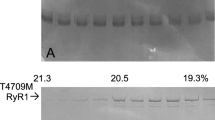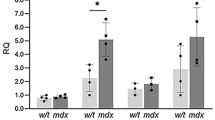Abstract
THE skeletal muscle dihydropyridine (DHP) receptor serves dual functions, as a voltage sensor for excitation–contraction coupling and as an L-type calcium channel1–3. Biochemical analysis indicates the presence of two forms of the DHP receptor polypeptide in skeletal muscle, a full-length translation product present as a minor species and a much more abundant form that has a truncated carboxy-terminus4–6. On the basis of these and other observations7, it has been proposed8 that, in skeletal muscle, only the full-length DHP receptor can function as a calcium channel and that the truncated form can only function as a voltage sensor for excitation–contraction coupling. To resolve this issue, we have now constructed a complementary DNA (pC6Δl) encoding a protein corresponding to the truncated DHP receptor in skeletal muscle. Expression of pC6Δl in dysgenic myotubes fully restores both excitation–contraction coupling and calcium current, consistent with the idea that a single class of DHP receptors performs both functions.
This is a preview of subscription content, access via your institution
Access options
Subscribe to this journal
Receive 51 print issues and online access
$199.00 per year
only $3.90 per issue
Buy this article
- Purchase on Springer Link
- Instant access to full article PDF
Prices may be subject to local taxes which are calculated during checkout
Similar content being viewed by others
References
Rios, E. & Brum, G. Nature 325, 717–720 (1987).
Tanabe, T. et al. Nature 328, 313–318 (1987).
Tanabe, T., Beam, K. G., Powell, J. A. & Numa, S. Nature 336, 134–139 (1988).
De Jongh, K. S., Merrick, D. K. & Catterall, W. A. Proc. natn. Acad. Sci. U.S.A. 86, 8585–8589 (1989).
Lai, Y., Seagar, M. J., Takahashi, M. & Catterall, W. A. J. biol. Chem. 265, 20839–20848 (1990).
De Jongh, K. S., Warner, C., Colvin, A. A. & Catterall, W. A. Proc. natn. Acad. Sci. U.S.A. 88, 10778–10782 (1991).
Schwartz, L. M., McCleskey, E. W. & Almers, W. Nature 314, 747–751 (1985).
Catterall, W. A. Cell 64, 871–874 (1991).
Tanabe, T., Mikami, A., Numa, S. & Beam, K. G. Nature 344, 451–453 (1990).
Armstrong, C. M., Bezanilla, F. M. & Horowicz, P. Biochim. biophys. Acta 267, 605–608 (1972).
Schneider, M. F. & Chandler, W. K. Nature 242, 244–246 (1973).
Adams, B. A., Tanabe, T., Mikami, A., Numa, S. & Beam, K. G. Nature 346, 569–572 (1990).
Lamb, G. D. & Walsh, T. J. Physiol., Lond. 393, 595–617 (1987).
Tanabe, T., Adams, B. A., Numa, S. & Beam, K. G. Nature 352, 800–803 (1991).
Taylor, J. W., Otto, J. & Eckstein, F. Nucleic Acids Res. 13, 8764–8785 (1985).
Mishina, M. et al. Nature 307, 604–608 (1984).
Hamill, O. P., Marty, A., Neher, E., Sakmann, B. & Sigworth, F. J. Pflügers Arch. ges. Physiol. 391, 85–100 (1981).
Nowycky, M. C., Fox, A. P. & Tsien, R. W. Nature 316, 440–443 (1985).
Author information
Authors and Affiliations
Rights and permissions
About this article
Cite this article
Beam, K., Adams, B., Niidome, T. et al. Function of a truncated dihydropyridine receptor as both voltage sensor and calcium channel. Nature 360, 169–171 (1992). https://doi.org/10.1038/360169a0
Received:
Accepted:
Issue Date:
DOI: https://doi.org/10.1038/360169a0
This article is cited by
-
Optogenetic approach for targeted activation of global calcium transients in differentiated C2C12 myotubes
Scientific Reports (2017)
-
Bridging the myoplasmic gap: recent developments in skeletal muscle excitation–contraction coupling
Journal of Muscle Research and Cell Motility (2007)
-
A short history of voltage‐gated calcium channels
British Journal of Pharmacology (2006)
-
Ion channels and ion transporters of the transverse tubular system of skeletal muscle
Journal of Muscle Research and Cell Motility (2006)
Comments
By submitting a comment you agree to abide by our Terms and Community Guidelines. If you find something abusive or that does not comply with our terms or guidelines please flag it as inappropriate.



